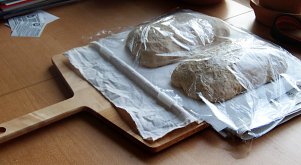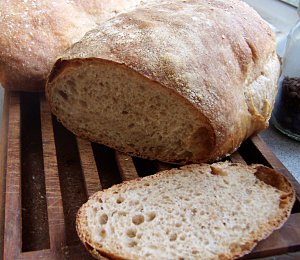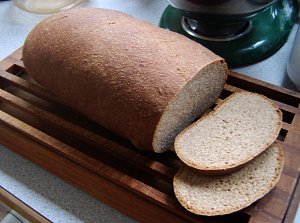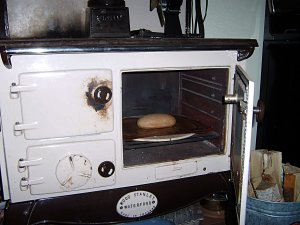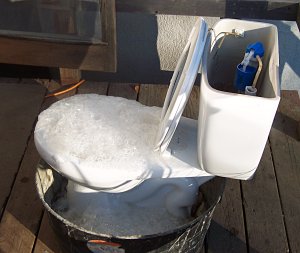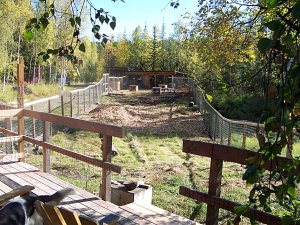I’ve had a Country Living Grain Mill for a couple years now, but without a motor, which meant grinding grains by hand. It’s certainly doable, but over time, I found that the time and effort it took to grind enough grain for a weeks worth of bread was becoming too much. As a result, I wasn’t making as many whole grain recipes.
They sell a variety of motorization kits, from the complete package (which is what I bought), to the parts you’d need to motorize it yourself with a separate motor.
The motor and kit I got is fantastic. It takes about fifteen minutes to grind enou wheat for a couple sandwich loaves, the flour doesn’t get overheated, and it grinds it very fine; equal to what you’d buy in the store.
Here’s the recipe I started this morning (makes two sandwich loaves) which comes from Peter Reinhart’s Artisan Breads Every Day:
Ingredients
- 250 g — Water (warmed to around 100°F)
- 283 g — Milk
- 1½ T — Yeast
- 284 g — White flour
- 550 g — Whole wheat flour
- 2 t — Salt
- 71 g — Honey
- 1 — Egg
- 56 g — oil
Directions
- Add water, milk, yeast, flour and honey to mixing bowl
- Mix egg and oil until blended, add to bowl
- Add yeast
- Mix with dough hook on medium speed for five minutes
- Rest, covered, for ten minutes
- Pull and fold dough twice, then rest ten minutes
- Repeat folding and resting three more times
- Refrigerate dough for one to four days in a covered, lightly oiled container
Baking
- Take dough out, let sit at room temperature for three hours
- Flatten dough into rectangle and roll into a loaf, put into greased loaf pan
- Let sit for two to three hours until dough has risen above the rim of the pan by around an inch
- Bake at 350°F for 40 minutes
I’ve had Daniel Leader’s Local Breads: Sourdough and whole-grain recipes from Europe’s best artisan bakers long enough to read most of the text in the book and bake three of the more than fifty bread recipes inside. The book begins with a few introductory chapters discussing the methods, ingredients and equipment you’ll need to bake the breads in the book. Subsequent chapters begin with a long section describing Leader’s experiences in a particular region of Europe, discussing the bakers, ingredients and bakeries he came across in his travels. After that, there are several recipes based on what he learned. The recipes are all scaled down for home ovens and equipment, have ingredients measured in volumetric units, U.S. and metric weights, as well as baker’s percentages. He says that he tested all the recipes using a small KitchenAid mixer, and the mixing instructions include specific details on speed and time for that mixer (as well as hand kneading instructions for most doughs). The majority of the recipes use sourdough for the fermentation, but including whole-grain in the title is a bit of a stretch since very few recipes are more than ten or twenty percent whole-grain (not a complaint, just a warning). At the end of the regional chapters is a list of frequently asked questions and answers that are tailored to the recipes. This is a nice Book 2.0 addition that would be welcome in most sophisticated baking books.
The three breads I’ve baked so far are his Old World Baguette (Paris), Buckwheat Batard (also Paris), and Whole Wheat Genzano Country Bread (Genzano, Italy). All of them were excellent, and the techniques involved were different from the recipes I’ve tried from Hamelman, Reinhart, or Beranbaum mostly because the doughs were so wet that they were difficult to shape using the techniques I’ve used in the past. If you’re going to be baking the breads from this book, you’ll probably need a good peel or a lot of parchment paper and a stand mixer.
Because the recipes are taken from different regions with their own baking traditions, there is less unity in technique than in the other books mentioned. Hamelman focuses on developing gluten with as little mixing and kneading as possible to maximize flavor and longevity, and the Reinhart whole grain book I recently reviewed revolves around pre-ferments and soakers or mashes. In Leader’s book you’ll find recipes using liquid levian, dough-like starters and starters raised on different grains; long-fermenting recipes with retarted proofing and recipes that are ready to bake a few hours after you start; recipes with a lot of kneading and recipes with much less. It’s a nice variety, and I’ve enjoyed seeing the results of variations in ingredients and technique in the final bread.
My only complaint with the book is that it’s not a sewn binding, which means that the book will eventually fall apart with the hard use it experiences in the kitchen. Hamelman’s bread book suffers from the same poor quality binding, and my copy recently split after three years of use. Contrast that with Whole Grain Breads, which has a sewn binding: it lays flat on the counter and will last a lifetime. Considering that both books list for $35, it’s a shame that Norton couldn’t produce a book up to the standards set by Ten Speed Press.
One other note: I’ve used my new SuperPeel (it’s the peel in the top photo) four or five times and I’m very happy with it. Thus far I haven’t used it to pick anything up, but it’s very good at smoothly laying dough down onto my baking stone in the oven, and when the belt is properly floured, the dough doesn’t stick to it. The only issue so far is that I haven’t found the optimum belt length yet such that the belt is tight to the peel but still allows it to move easily. My previous method for handling dough was to proof the loaves on a Silpat, which is a sort of reusable silicone parchment paper. It is very durable and works, but because the bread isn’t being place directly onto the heated stone, I wasn’t getting as much oven spring as I do now with the SuperPeel. Later this week I’m planning to make pizza, and we’ll see how easy it is to pick up and put down a big pizza. That’s the true test.
A couple weeks ago I finished reading Peter Reinhart’s Whole Grain Breads, and baked my first loaf. I chose the whole wheat sandwich loaf even though I much prefer hearth breads because it was the teaching recipe that all the other recipes are based on. The bread was fantastic; sweet, not too dry, and with a lot of wheat flavor. And, best of all for a homemade sandwich bread, it lasted until Friday without losing any of it’s flavor or character.
I have also made the whole wheat pizza dough twice, and it’s equally good. Our previous dough recipe was Cook Illustrated’s 75-minute pizza dough, which tastes pretty good, and has sufficient gluten development to form a pizza crust, but once it’s baked with sauce, toppings and cheese, it’s not really strong enough to handle picking up the slices. The whole wheat dough was sturdy enough, and again, it had the same sweet wheat flavor and nice texture as the sandwich loaf. The recipe in the book makes five individual pizzas, which was more dough that I needed for a single large pizza (I reduced the recipe by 25% the second time around and it was perfect) so I used the leftover dough the next day to bake a small loaf in the wood stove oven. The oven was around 425°F, which is a little hotter than the baking temperatures in the book, and I should have rotated the loaf half-way through because the oven heat isn’t very even, but the loaf came out great.
Since then I’ve made whole wheat hearth bread, which was tasty, but lost some of it’s height when I transferred it to the baking stone (I’ve got a Super Peel coming, which should help with this problem), and oat bran broom bread. Both came out great tasting with excellent crumb, and still had great texture and flavors when I finished the loaf.
The method used in almost all the breads in the book is different than any of the techniques I’ve seen in other books. Most quality breads have a long pre-ferment, either using sourdough or a lightly yeasted dough that rises slowly overnight and is mixed in on baking day, and usually feature low amounts of yeast which require long several-stage fermentation on baking day to develop gluten and the yeast. Reinhart’s method for developing the dough is to use a lightly yeasted pre-ferment as in the other recipes, plus an soaker that rests overnight at room temperature. These two doughs form the majority of the final dough. They’re mixed on baking day with the rest of the ingredients, and a relatively large amount of yeast. Since the flavors and structure has already been developed in the two overnight doughs, there’s no reason for a long fermentation on baking day. The technique also works wonders on whole grain flours, which can result in dense loaves in traditional recipes.
The result is bread with all the flavor and keeping potential of traditional recipes but you can use much higher percentages (like 100%) of whole grain flours with greater confidence that the bread will turn out, and best of all, baking day becomes a two hour process, rather than a four to six hour, multiple stage, slow fermentation procedure. I’m not going to abandon my other bread books, but it’s great to have more techniques at my disposal when deciding what kind of bread to make. And Reinhart can be commended for all the research and testing he did to develop the methods in this book.
I highly recommend Whole Grain Breads to anyone who is really interested in bread baking, especially if you’re ready to jump onto the whole grain bandwagon.
Things are slowing down as the house is ready for winter and almost everything is gone from the old place. A couple more trips this weekend and I hope we’ll be done moving. We haven’t done much unpacking, but there will be plenty of time for that now that it’s starting to get cold.
After the sunrise this morning I took Nika out on one of the trails on the other side of the road from our driveway. There’s a trail that goes along the road, and off that is a trail that goes mostly east up over the ridge, which is where I took Nika. It’s about ¾ of a mile to where the trail intersects what looks like it might be a road, but since I didn’t know where I was, I turned around and came back. You can sort of see what the environment looks like from the photo on the right. The forest was dark and the sky was lit with the sunrise, so it was hard to get a good photo.
The other photo shows the toilet repair I did earlier today. The toilet didn’t flush “all the way,” even when there wasn’t anything but liquid in the bowl. I was worried that it was installed incorrectly, but the plumber that came to charge our glycol lines said it was just scale inside the toilet. He suggested getting some hydrochloric acid and letting it dissolve the scale by running it through the toilet. But since we’ve got our own sewage treatment plant that needs to be treated gently (the instruction manual says we need to treat it like a pet, since it's a living system), I pulled the toilet out of the house and ran acid through it from the top tank into the bowl. I’m glad I did it outside, since the reaction released some really nasty smelling (and probably poisonous) gases. The photo is what happened when I neutralized the acid with a couple boxes of baking soda. The acid came with a pH testing kit to verify the acid was neutralized before disposing of the solution.
After all that, I wiped it down, installed a new wax ring, and screwed the toilet back in place. Turns out the plumber was exactly right: now it flushes like a toilet should.
I also made some time to try out a recipe from Peter Reinhart’s Whole Grain Breads. I finished reading the book last night and prepared the soaker and biga for the basic whole wheat sandwich loaf. Reinhart calls his new baking method a delayed fermentation, “epoxy” method where a large percentage of the dough is prepared in advance. Half of it is a traditional pre-ferment, with either a small amount of yeast added, or is a sourdough; and the other half is a soaker or mash that sits overnight, allowing enzymes to develop flavor and enhance the dough structure and fuel for fermentation. On baking day, you mix the two blobs of dough with the remaining flour, yeast and other ingredients, knead and bake it. Most of the gluten and flavors are developed overnight, so even though the entire process takes more than one day, it involves less effort on each day.
It’s just out of the oven now. Tomorrow, when the bread has cooled, I’ll have a report on how it turned out, but it rose nicely, and I got enough oven spring that the loaf is quite round in cross section.

